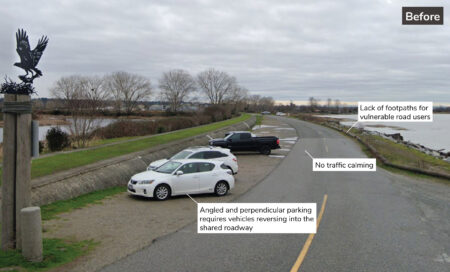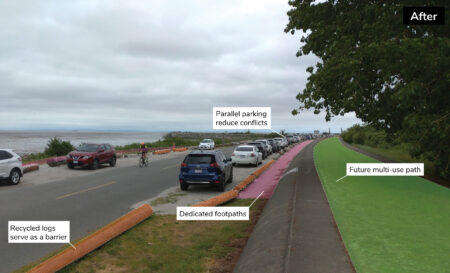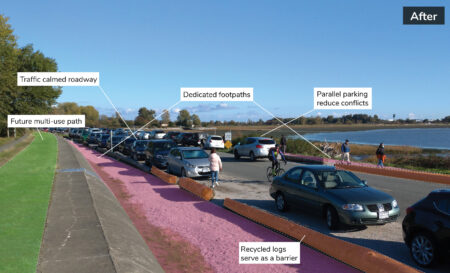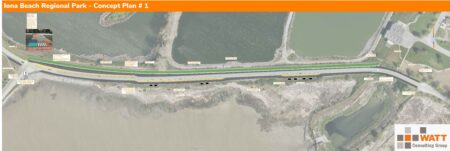Creative Solutions by WATT’s Transportation Division Solves Traffic Woes at Summer Hot Spot
Creative Solutions by WATT’s Transportation Division Solves Traffic Woes at Summer Hot Spot
WATT assists Metro Vancouver with quick-build retrofit at Iona Beach Regional Park using natural materials found on-site to better manage parking, preserve the natural environment, traffic calm the roadway, and improve the experience of people walking and biking.
#WEAREWATT
Before + After
click to enlarge
Location
In the wake of the COVID-19 pandemic came a sharp drop in trips to offices and a huge increase in trips to parks and open spaces as people looked for ways to redefine their relationships with the built and natural environments.
One of the parks which felt a direct impact from these changes in travel patterns was the scenic Iona Beach Regional Park (Link for Map), located just north of the Vancouver International Airport in Richmond, BC.
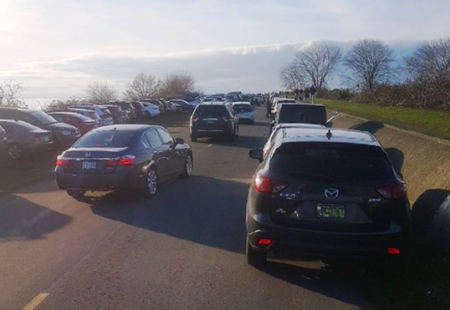
Figure 2 Sunny days bring out the crowds and parking problems at Iona Beach in Spring 2021. Source: Metro Vancouver
Site Challenges
Iona Beach Regional Park is a unique area of land made up of two long, narrow jetties of sand as well as wetlands and unique dune habitat along the mouth of the Fraser River where it meets the Georgia Strait. One of the jetties also serves as a sewage outflow pipe that is wide enough to allow people to walk on top of it. Nested within the Pacific Flyway, the Park is a pathway for thousands of migratory birds.
In addition to visitors coming to check out these unique features, the COVID summer of 2020 saw half a million visitors to the Park. This was almost 25% higher than normal conditions resulting in severe traffic congestion and overflow of parked vehicles along Ferguson Road (see Figure 2.), the only access road to the Park.
This became a cause for concern for the Parks and Environment Department at the Metro Vancouver Regional District. A lack of transit facilities near the Park (closest transit facility is the Templeton Canada Line station approximately 6.5km away) led to an increase of private automobiles which resulted in haphazard parking, walking on travel lanes, and increased conflicts with people cycling to the Park for training and/or recreational purposes.
WATT Team Engaged
Metro Vancouver reached out to WATT Consulting Group in February 2021 to review and recommend improvements to a one kilometre stretch of Ferguson Road to better manage automobile parking, preserve natural environment that was being damaged by automobile parking (see Figure 3), traffic calm the roadway, and improve the experience of people walking and biking.
With another busy summer season quickly approaching at Iona Beach, Metro Vancouver requested two concepts to help improve conditions in the short term. With a capital budget of $40,000 and a need to install the improvements in a very short period of time, the WATT team mobilized quickly. Our Regional Lead for Vancouver’s office Thomas Thivener served as project manager. His experience retrofitting Complete Streets and managing the active transportation spot improvement program for the City of Calgary came in handy. He was assisted by Transportation Planning Engineer, Jeeshan Ahmed, and Transportation Designer, Brian Soch.
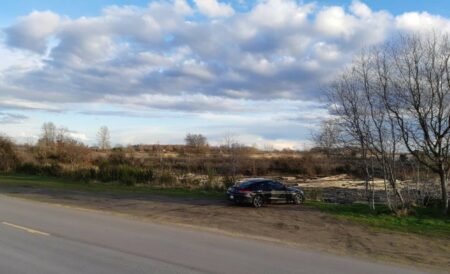
Figure 3 Haphazard parking led to the destruction of natural environment at Iona Beach Regional Park.
Source: Thomas Thivener
Project Team
Thomas Thivener
Project Manager
Jeeshan Ahmed
Transportation Planning Engineer
Brian Soch
Transportation Designer
Spring 2021 Improvements
The existing angled and perpendicular parking arrangement on Ferguson Road was converted to parallel parking stalls to eliminate any safety issues from parking maneuvers reversing onto the road which is currently shared with vulnerable road users including people cycling. The change in parking layout opened up additional space for dedicated footpaths on both sides of the road. The footpaths now allow people to park and walk towards the jetty and the rest of the Park’s trail network (Figure 4).
Getting Creative, Affordably!
Metro Vancouver’s desire to maintain a natural look and feel to the improvements was addressed in the concept plan with the use of readily available logs as a separation treatment between the parked automobiles and the new footpaths. The placement of the logs created designated parking areas while preventing parking where it was not desired or safe. The placement of the logs also allowed easy access between the new footpaths and the parallel parking. Overall, the quick build improvements met the needs of Iona Beach visitors while reducing negative impacts to the natural environment.
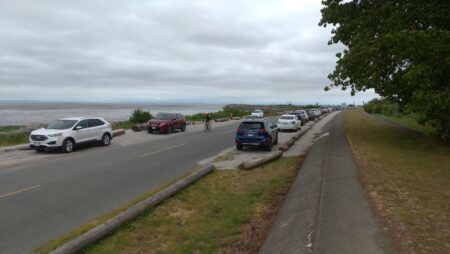
Figure 4 View from the sewage outfall pipe of the new parallel parking and foot paths at Iona Beach Regional Park. Source: Thomas Thivener
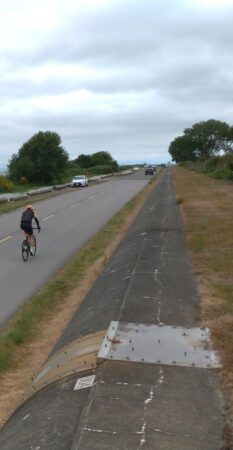
Figure 5 Existing sewage pipe could be converted into a multi-use pathway down the line. Source: Thomas Thivener
Recommended Additional Improvements
- Installation of an enhanced crosswalk on Ferguson Road where the first of two jetties begin. The conventional zebra crossing may be replaced with a decorative crosswalk with help from local artists to further complement the Park’s natural features.
- Two speed tables are also recommended for people driving to adhere to the 30 km/h posted speed limit within the park.
- Additional bike racks could be installed to help encourage use of more sustainable and active modes to the Park.
- Picnic tables can also be placed on the south side of Ferguson Road, where space permits, to encourage group gatherings and add to the vibrancy of the park.
- Stairs can be placed on the north side of Ferguson Road to provide additional connections for pedestrians to the existing trail that runs on top of a sewage pipe parallel to the road.
Other Opportunities
- There is potential for the existing sewage pipe to be converted into a multi-use pathway down the line (Figure 5).
Takeaways
Corridor retrofits using quick-build improvements allow a place or street to benefit from improved mobility (Figure 6) on a tight budget while providing flexibility to alter the improvements later if necessary. This can also be a tool to help build public interest and support for additional or permanent improvements. In Metro Vancouver’s case, the success of this interim change may create the need for paving one of the footpaths and converting them into a multi-use path in the future.
The possibilities are endless!
All it takes is a good understanding of the problem
and a creative vision to improve a street.
Figure 6 People cycling towards the exit of Iona Beach Regional Park on Ferguson Road after logs and a footpath were installed. Source: Thomas Thivener
Need a creative solution for your unique traffic woes?
Request a Proposal from WATT’s Transportation team today.
Serving communities in Alberta, British Columbia, and beyond!
